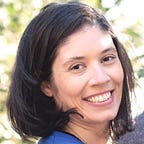A few weeks ago, I began a journey to become a data scientist, by enrolling in the Data Science bootcamp offered by the Flatiron School. My instructors have challenged me to answer this question: Why data science?
The short answer is that I find data wrangling and analytics fascinating and enjoyable. While working in hospital finance, I often ran SQL reports and analyzed them in Excel. I became drawn to data, to the stories it could tell, and to its thorny, patchwork, unpredictable nature that requires careful attention to detail.
During a brief stint on the Analytics team of a start-up company, I saw the immense power wielded by the data scientists there. They could answer complex questions and predict future outcomes with a few keystrokes. Ok, with a lot of keystrokes, but still with less effort and more grace than I could muster using SQL and Excel alone. I longed to have the coding knowledge necessary to answer challenging questions, and to learn that secret language (something about a snake? or cute bears?) that was the key to finding the answers.
After that job, and a subsequent consulting position at a hospital, I took three years off when my second child was born. I loved my years as a stay-at-home parent, but also thought constantly about the future, when I would return to work. Although my previous work experience was in hospital administration, I dreamed of making a pivot to data science.
I thought data science would be the opposite of kid care. Instead of running after children and carrying them around, I would sit in a comfy chair. Instead of constant cries and shrieks, a quiet room. Instead of days spent repeating the same activities over and over, my brain would be constantly stimulated by new challenges and puzzles.
It seemed blissful, and still does. But after just a month in the bootcamp, I have noticed that there are some similarities between data science and small children. For example, many parents will attest that their child sometimes throws a tantrum when events do not proceed exactly as she expected. Python sometimes throws the same tantrum. Come on, I mutter to the computer, you know I meant to put a period there, not a comma, so get over it instead of throwing a multi-paragraph red-and-green-text error. And trying different code snippets to achieve the desired result sometimes feels like coaxing my daughter to put on her shoes or get in the car. I try calm encouragement, stern rules, distraction, and bribes, in the same way I might try four different pieces of code. Both child care and data wrangling require a lot of patience, and a willingness to start over or try something new when things don’t go as planned.
In all seriousness, my ambition is to build hard skills in the programming languages necessary for data mining and data wrangling, and to develop a better understanding of statistical analysis. I hope to use these skills to solve problems related to public health and health care delivery.
Health care data is fascinatingly complex and absurdly fragmented in the U.S., which oddly is part of its appeal to me. Since we have no national health system, each electronic health record, hospital billing system, and insurance company database stores data differently. Even within large insurance companies or provider networks, understanding data requires amalgamating information from different lines of care for each patient. As more health data becomes available from various sources such as personal health management apps, even more work will be required to standardize it for analysis.
I find making sense out of messy data extremely satisfying. I don’t mind being stuck in the tangle of EHR data, billing data, lab data, payment data, provider data, and imaging data, since working out the knots with a fine-tooth comb is so enjoyable. I don’t mind flailing in the quagmire of diagnosis-related groups, procedure codes, diagnosis codes, modifiers, professional codes, technical codes, duplicate patients, duplicate bills, duplicate visits, and null values for a while, since making sense of it all is fun.
At a high level, I would love to mine and interpret data, and then communicate my findings to stakeholders. Explaining concepts is something I enjoy. In my previous jobs, I often trained others on how to use the hospital revenue cycle application, how to run reports, and even how to use Excel. I don’t know how most things work, from cars to furnaces to lawn care. So, I took pleasure in explaining ideas and workflows in an accessible and friendly manner, knowing that I like to be taught this way as well. (I can’t count how many times I’ve watched a car mechanic or home services provider wince at my utter cluelessness). My desire to communicate accessibly extends to enjoying designing dashboards and interactive reports in a clear manner. I think the clear presentation of ideas is a key responsibility of a data scientist, and I would try my best to be up to the task.
I hope this bootcamp is the first step in a long journey into learning programming languages, deepening my understanding of statistics, and honing my communication skills. Hopefully most of that can be done in a comfy chair.
